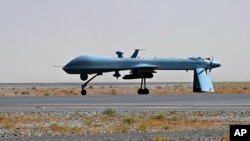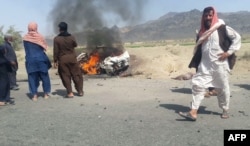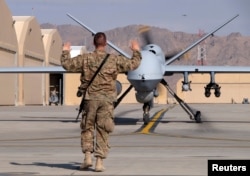On March 2, a suspected U.S. drone strike inside Pakistan killed two Taliban militants in the country's tribal region — the first drone attack in the country since Donald Trump became president.
The strike ended a nine-month pause in the CIA's long-running drone war in Pakistan, raising expectations that the Trump administration will increase the targeted killings of militants in the Pakistani tribal areas. But with the administration focused on defeating the Islamic State group in Iraq and Syria, few expect a large expansion in the Pakistan drone campaign, let alone a return to 2010 when the U.S. carried out a record 122 drone strikes in Pakistan.
Instead, many experts see a more modest escalation even as strikes elsewhere pick up more dramatically.
"I'd expect the campaign to be escalated at some point and probably get back to somewhere at the levels of the middle to the height of the Obama administration," said Bill Roggio, editor of the Long War Journal at the Foundation for Defense of Democracies in Washington.
Drone use under Obama, Bush
A Pentagon spokesman said the U.S. military was not responsible for the March 2 strike in Pakistan. The CIA declined to comment.
Until the Obama administration began releasing information about drone strikes last year as it handed over the program to the Pentagon, the campaign in Pakistan was shrouded in secrecy. But investigations carried out by the New America Foundation, the London-based Center for Investigative Journalism and others documented a massive escalation in Pakistan strikes.
Under former President George W. Bush, the U.S. carried out 48 strikes to kill "high-value targets" among al-Qaida and the Taliban, the New America Foundation reported. President Barack Obama's administration, however, made the use of drones a centerpiece of its anti-terror strategy as it drew down U.S. forces in Afghanistan and Iraq. New America Foundation data indicate the U.S. carried out at least 354 drone strikes in Pakistan under Obama, killing as many as 2,700 militants.
The last known Pakistan drone strike during the Obama administration came last May when a missile killed Taliban leader Mullah Mansour in Balochistan province. By then, drone strikes had declined sharply from their 2010 peak, and no others were reported until March 2.
Several explanations have been offered for the pause. For one, the strike on Mullah Mansour crossed a Pakistani red line on drone attacks outside the country's tribal areas, drawing the ire of Islamabad, which had long privately endorsed U.S. drone strikes while publicly condemning them, said Brian Williams, author of Predators: the CIA's Drone War on al Qaeda and a professor at the University of Massachusetts Dartmouth.
Also, with the rise of IS in 2014, the U.S. began shifting its focus — and drone assets — to Iraq and Syria. In addition, there was a dwindling list of militant targets in Pakistan as drone strikes decimated their ranks and a Pakistani Army offensive pushed the remainder into neighboring Afghanistan.
'Result of success'
"It was the result of success," Williams said. "The drones were very successful in degrading and destroying al-Qaida Central."
While Obama approved seven times as many drone strikes as his predecessor, he also put in place stringent limits on their use. Among those measures there was a centralized White House approval system for drone strikes, which required "near certainty" on the part of military commanders that a strike would not cause large numbers of civilian casualties.
Now, as the Trump administration ramps up counter-terrorism efforts, it has sought to reverse some of those rules, making it easier for the military and the CIA to conduct drone strikes. The Wall Street Journal reported earlier this month that the Trump administration has restored the CIA's authority to use drones while the New York Times reported that Trump has approved the Pentagon's request to declare parts of Yemen "areas of active hostilities."
The result has been a spike in reported airstrikes, by both drones and manned aircraft. In one five-day period starting in late February, the U.S. carried out 40 strikes against al-Qaida targets in Yemen, according to the Pentagon, which did not indicate how many were by drones. And in Iraq, the U.S. is investigating reports that a series of airstrikes on March 17 killed more than 100 civilians in western Mosul's Old City.
Although drone strikes fell in Pakistan in recent years, in Afghanistan the number of airstrikes — manned and unmanned — has risen sharply over the past two years. As of Thursday, the U.S. military carried out 374 airstrikes in Afghanistan this year, compared with 1,071 strikes in all of last year, said Captain William Salvin, a spokesman for U.S. forces in Afghanistan. The Bureau of Investigative Journalism recorded approximately 235 strikes in 2015.
'Target rich' area
While Salvin would not break down the data to show the number of drone strikes, anecdotal evidence suggests that an increasing number are conducted by unmanned aircraft.
"My assumption is that there are a lot of them that are carried out by drones," said Williams.
Roggio of the Long War Journal said Afghanistan and Pakistan remain a "target rich" region, with dozens of terrorist groups operating in the two neighboring countries. But to be effective, a drone program must maintain a high operational tempo, he said.
"If you're just plinking at them and conducting a couple of strikes a month killing a senior leader every now and then, these groups have a capacity to replace them," he said. "If you want to do targeted killings against jihadist groups, then you'd better be prepared to conduct hundreds upon hundreds, if not thousands of strikes a year, to go after these groups."
In Afghanistan and Pakistan, drone operations are primarily flown out of bases in Jalalabad and Kandahar. At their peak, from 2008 to 2010, as many as 28 drones were deployed in Afghanistan, said Williams, adding that the number has declined in recent years. Salvin would not disclose the number for security reasons.













